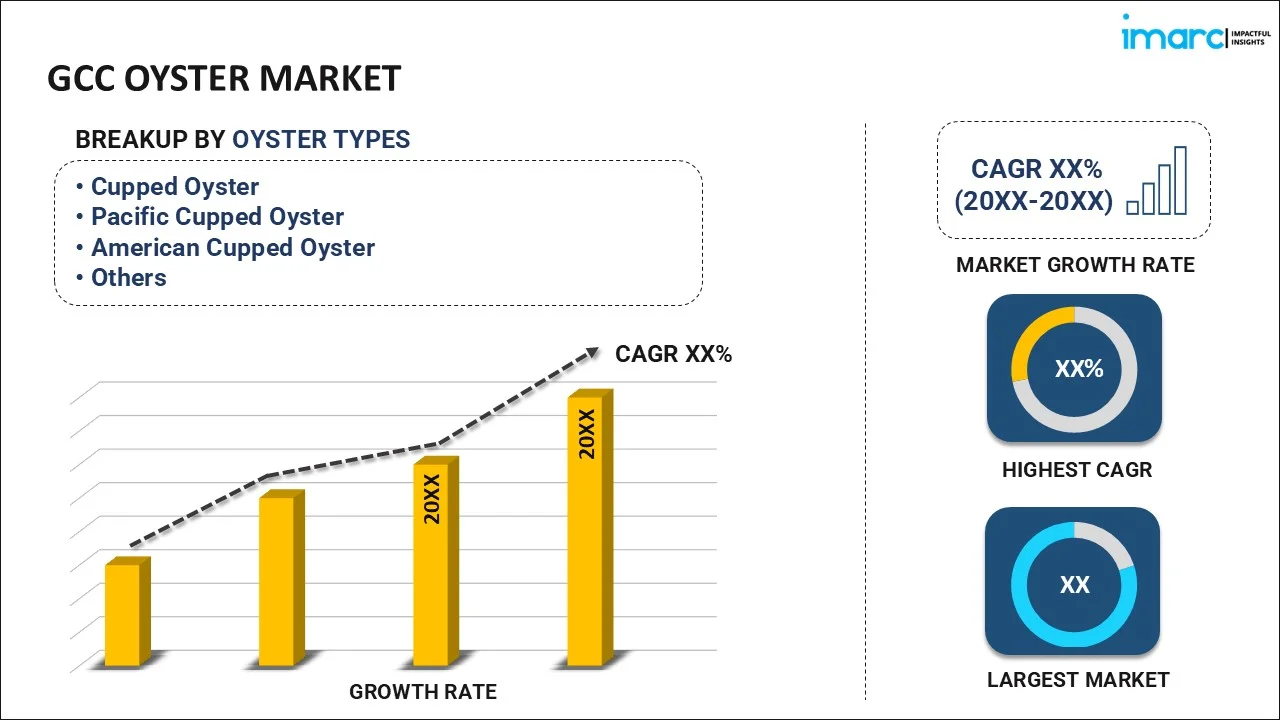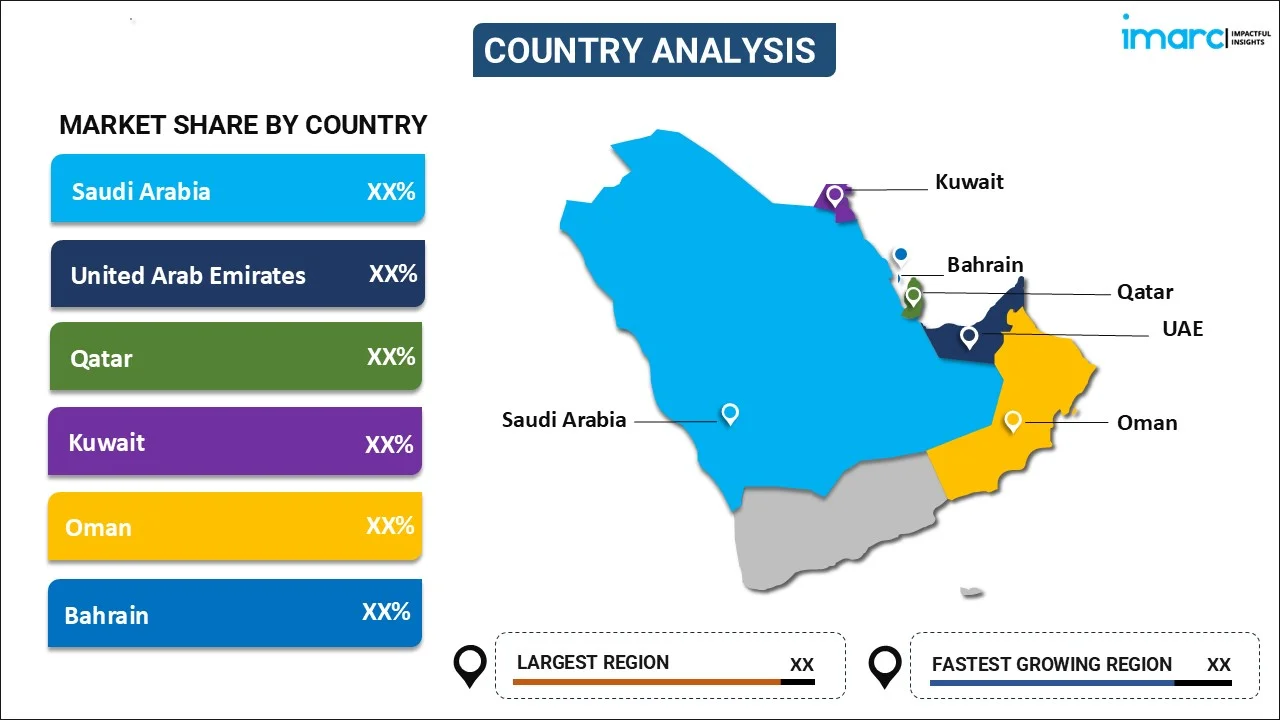
GCC Oyster Market Report by Oyster Type (Cupped Oyster, Pacific Cupped Oyster, American Cupped Oyster, Penguin Wing Oyster, and Others), End User (Foodservice, Retail), Form (Fresh, Frozen, Canned, and Others), and Country 2025-2033
Market Overview
The GCC oyster market size reached 881.8 Kilo Tons in 2024. Looking forward, IMARC Group expects the market to reach 1,243.9 Kilo Tons by 2033, exhibiting a growth rate (CAGR) of 3.32% during 2025-2033. The growing number of fine-dining and high-end restaurants serving premium quality seafood, rising number of tourists seeking unique and exclusive culinary experiences, and increasing adoption of sustainable oyster farming methods represent some of the key factors driving the market.
|
Report Attribute
|
Key Statistics
|
|---|---|
|
Base Year
|
2024 |
|
Forecast Years
|
2025-2033
|
|
Historical Years
|
2019-2024
|
| Market Size in 2024 | 881.8 Kilo Tons |
| Market Forecast in 2033 | 1,243.9 Kilo Tons |
| Market Growth Rate (2025-2033) | 3.32% |
The oyster, a distinct species of marine mollusk, belongs to the family of bivalves and is identifiable by its sturdy shell, which is calcified and composed of two interlocking parts. It thrives both in freshwater and saline environments, predominantly occupying shallow coastal regions and estuaries. It possesses hard shells, which are used for its protection and provide valuable habitats for a diverse range of marine life. It is known for its high concentration of omega-3 fatty acids, which are required for maintaining heart health and are often deficient in typical diets. It acts as a filter feeder and filters surrounding water through its gills to obtain nourishment, playing a significant part in improving water quality by eliminating excess nutrients and sediment. It also aids in establishing a healthier ecosystem by facilitating a balanced nutrient profile in the water bodies it inhabits. It is a highly nutritious source of food, rich in protein, vitamins, and minerals. It also bolsters the immune system and improves cardiovascular health. As it produces oyster reefs that contribute significantly to coastal stability and reduce wave energy, curtail erosion, and reinforce the shoreline, the demand for oyster is rising in the GCC region.
GCC Oyster Market Trends:
At present, the increasing demand for oysters as a gourmet delicacy and a symbol of luxury among the affluent population represents one of the crucial factors influencing the market positively in the GCC region. Moreover, the rising number of fine-dining and high-end restaurants serving premium quality oysters to their customers is strengthening the growth of the market. Apart from this, the growing number of tourists seeking unique and exclusive culinary experiences while traveling is offering a positive market outlook in the GCC region. Additionally, the rising focus on consuming a balanced and nutritious diet to prevent the occurrence of various chronic ailments is offering lucrative growth opportunities to industry investors in the GCC region. In line with this, the increasing adoption of sustainable and effective oyster farming methods along with the employment of advanced aquaculture techniques, such as offshore farming and the use of environmentally friendly equipment, to enhance production efficiency and minimize environmental impact is impelling the market growth in the region. Besides this, the increasing awareness about the health benefits of oysters among the masses is propelling the growth of the market in the GCC region. In addition, the number of various e-commerce and online platforms selling fresh oysters at reasonable prices and delivering them to the doorstep of buyers is bolstering the growth of the market. Furthermore, rising initiatives taken by the governing agencies in the region to promote aquaculture and reduce dependency on imports by providing financial assistance and developing infrastructure for local oyster farming activities is contributing to the growth of the market in the GCC region.
GCC Oyster Market Segmentation:
IMARC Group provides an analysis of the key trends in each segment of the GCC oyster market report, along with forecasts at the regional and country levels for 2025-2033. Our report has categorized the market based on oyster type, end user, and form.
Oyster Type Insights:

- Cupped Oyster
- Pacific Cupped Oyster
- American Cupped Oyster
- Penguin Wing Oyster
- Others
The report has provided a detailed breakup and analysis of the market based on the oyster type. This includes cupped oyster, Pacific cupped oyster, American cupped oyster, Penguin wing oyster, and others. According to the report, cupped oyster represented the largest segment.
End User Insights:
- Foodservice
- Retail
- Supermarkets and Hypermarkets
- Convenience Stores
- Specialty Outlets
- Online Channels
- Others
A detailed breakup and analysis of the market based on the end user has also been provided in the report. This includes foodservice and retail (supermarkets and hypermarkets, convenience stores, specialty outlets, online channels, and others). According to the report, retail accounted for the largest market share.
Form Insights:
- Fresh
- Frozen
- Canned
- Others
A detailed breakup and analysis of the market based on the form has also been provided in the report. This includes fresh, frozen, canned, and others. According to the report, fresh accounted for the largest market share.
Country Insights:

- Saudi Arabia
- UAE
- Qatar
- Bahrain
- Kuwait
- Oman
The report has also provided a comprehensive analysis of all the major regional markets, which include Saudi Arabia, UAE, Qatar, Bahrain, Kuwait, and Oman. According to the report, UAE was the largest market for oyster in GCC. Some of the factors driving the UAE oyster market included the growing health consciousness among the masses, increasing number of fine dining restaurants and high-end restaurants serving premium oysters, rising e-commerce platforms selling oysters, etc.
Competitive Landscape:
The report has also provided a comprehensive analysis of the competitive landscape in the GCC oyster market. Competitive analysis such as market structure, key player positioning, top winning strategies, competitive dashboard, and company evaluation quadrant has been covered in the report. Also, detailed profiles of all major companies have been provided.
GCC Oyster Market Report Coverage:
| Report Features | Details |
|---|---|
| Base Year of the Analysis | 2024 |
| Historical Period | 2019-2024 |
| Forecast Period | 2025-2033 |
| Units | Kilo Tons |
| Scope of the Report | Exploration of Historical and Forecast Trends, Industry Catalysts and Challenges, Segment-Wise Historical and Predictive Market Assessment:
|
| Oyster Types Covered | Cupped Oyster, Pacific Cupped Oyster, American Cupped Oyster, Penguin Wing Oyster, Others |
| End Users Covered |
|
| Forms Covered | Fresh, Frozen, Canned, Others |
| Countries Covered | Saudi Arabia, UAE, Qatar, Bahrain, Kuwait, Oman |
| Customization Scope | 10% Free Customization |
| Post-Sale Analyst Support | 10-12 Weeks |
| Delivery Format | PDF and Excel through Email (We can also provide the editable version of the report in PPT/Word format on special request) |
Key Questions Answered in This Report:
- How has the GCC oyster market performed so far and how will it perform in the coming years?
- What has been the impact of COVID-19 on the GCC oyster market?
- What is the breakup of the GCC oyster market on the basis of oyster type?
- What is the breakup of the GCC oyster market on the basis of end user?
- What is the breakup of the GCC oyster market on the basis of form?
- What are the various stages in the value chain of the GCC oyster market?
- What are the key driving factors and challenges in the GCC oyster market?
- What is the structure of the GCC oyster market and who are the key players?
- What is the degree of competition in the GCC oyster market?
Key Benefits for Stakeholders:
- IMARC’s report offers a comprehensive quantitative analysis of various market segments, historical and current market trends, market forecasts, and dynamics of the GCC oyster market from 2019-2033.
- The research study provides the latest information on the market drivers, challenges, and opportunities in the GCC oyster market.
- Porter's five forces analysis assist stakeholders in assessing the impact of new entrants, competitive rivalry, supplier power, buyer power, and the threat of substitution. It helps stakeholders to analyze the level of competition within the GCC oyster industry and its attractiveness.
- Competitive landscape allows stakeholders to understand their competitive environment and provides an insight into the current positions of key players in the market.
Need more help?
- Speak to our experienced analysts for insights on the current market scenarios.
- Include additional segments and countries to customize the report as per your requirement.
- Gain an unparalleled competitive advantage in your domain by understanding how to utilize the report and positively impacting your operations and revenue.
- For further assistance, please connect with our analysts.
 Request Customization
Request Customization
 Speak to an Analyst
Speak to an Analyst
 Request Brochure
Request Brochure
 Inquire Before Buying
Inquire Before Buying




.webp)




.webp)












